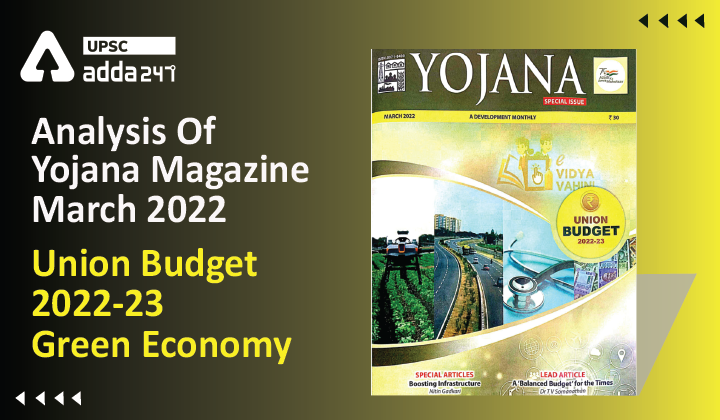Table of Contents
Analysis Of Yojana Magazine March 2022: ”Union Budget 2022-23 – Green Economy”
Introduction
- Climate action has been highlighted as one of the priority areas in the budget, along with inclusive development, energy transition, financing of investments, among others.
- Acknowledging that the climate crisis is among the strongest negative externalities affecting India, the Finance Minister announced several measures to help the country transition to a low-carbon economy.
How Climate Change is affecting us?
- Climate change-induced heat waves, hurricanes, droughts, and rising sea levels are already having a negative impact on the environment.
- Communities across the world have been affected, resulting in the loss of lives and a lower standard of living.
- According to Food and Agriculture Organization (FAO), the frequency and intensity of climate-related catastrophes have increased globally, resulting in $1.5 trillion in economic losses from 2003 to 2013.
- This indicates the importance of increasing public and private investment in climate adaptation measures, especially in developing countries like India that are highly vulnerable to climate change and its associated impacts.
What is a Green Economy?
- A green economy is defined as low carbon, resource-efficient and socially inclusive.
- In a green economy, growth in employment and income is driven by public and private investment into such economic activities, infrastructure and assets that allow reduced carbon emissions and pollution, enhanced energy and resource efficiency, and prevention of the loss of biodiversity and ecosystem services.
Key Measures
- The measures include an increased allocation of ₹19,500 crores for the Production Linked Incentive (PLI) scheme for the domestic manufacturing of solar modules that will aid in the attainment of 280 GW of installed solar capacity by 2030.
- This is also envisaged to generate significant employment opportunities in the country.
- The proposal to co-fire 5-7% biomass pellets in thermal power plants, will result in carbon dioxide reduction, besides providing a source of income to farmers and aiding in the reduction of stubble burning.
- In a further impetus to the Electric Vehicles (EV) ecosystem, a battery swapping policy has been announced and the need for the development of interoperability standards have been highlighted.
- The focus of the budget on urban planning, clean technology, and public transport, is a step in the right direction and will be instrumental in giving the much-needed boost to the EV industry in the country.
- On the energy efficiency front, the development of an Energy Service Company (ESCO) business model in large commercial buildings, capacity creation and awareness for energy audits, performance contracts, and a standard framework for measurement and verification process will be facilitated.
Sovereign Green Bonds
As an indicator of the country’s seriousness towards climate action, sovereign green bonds have been announced under the government’s overall market borrowings in 2022-23. The bonds will be used to raise funds for environmentally friendly or climate-friendly infrastructure. The proceeds from the bonds will be used to fund public-sector projects that will reduce the economy’s carbon intensity.
National Clean Air Program
The budget has also prioritised clean air in the environment sector, with goals across ministries and sectors, including the National Clean Air Program under the Ministry of Environment, Forest and Climate Change, as well as the ministries of Power, New and Renewable Energy, and Urban Affairs. To tackle air pollution, ₹2,217 crores have been earmarked for 42 urban centres with a million-plus population.
Mainstreaming Climate change
Mainstreaming climate change in India’s budgeting and planning process as done by many other countries, would have been a perfect start to the integration of development and economic statistics with Green metrics.
National Adaptation Investment Plan
- This plan will serve as a national portfolio of investment-ready adaptation investments for the private sector and international climate funds.
- This will not only give a complete overview of priority sectors and funds available to the private sector but will also allow the Government to systematically raise climate finance from the market.
- Carrying out such activity will also contribute to the private sector’s understanding of local adaptation needs.
- As one of the pillars of climate finance, adaptation finance has a key role to play in helping developing countries scale up their climate change adaptation efforts.
Conclusion
In Summary, through the voluntary vehicle scrapping policy, funds for tackling air pollution, battery swapping policy, the allocation for waste management to reduce plastic waste, the Government has shown that climate change is an area of immediate priority for the nation. Even though the announcement on sovereign green bonds is a welcome step, it is imperative to define a structured framework for the realisation of its potential.



 TSPSC Group 1 Question Paper 2024, Downl...
TSPSC Group 1 Question Paper 2024, Downl...
 TSPSC Group 1 Answer key 2024 Out, Downl...
TSPSC Group 1 Answer key 2024 Out, Downl...
 UPSC Prelims 2024 Question Paper, Downlo...
UPSC Prelims 2024 Question Paper, Downlo...
